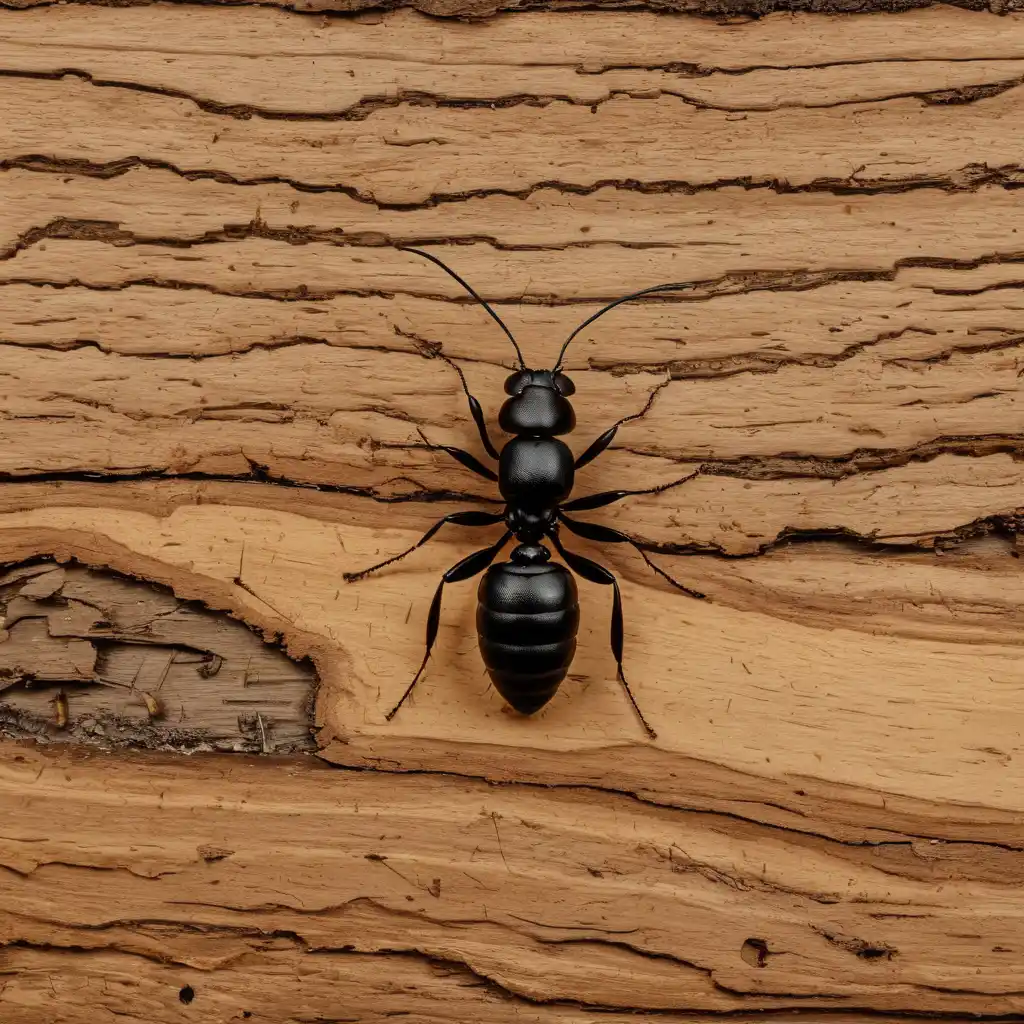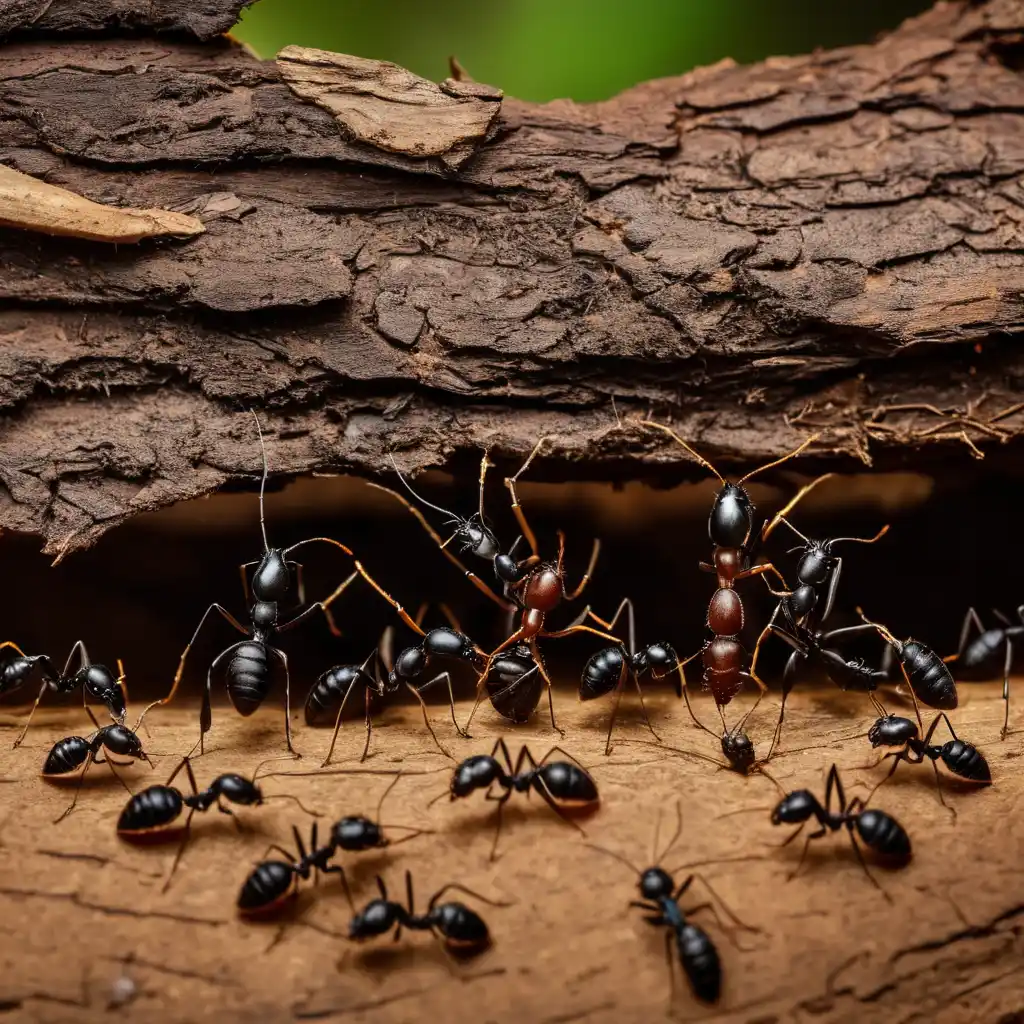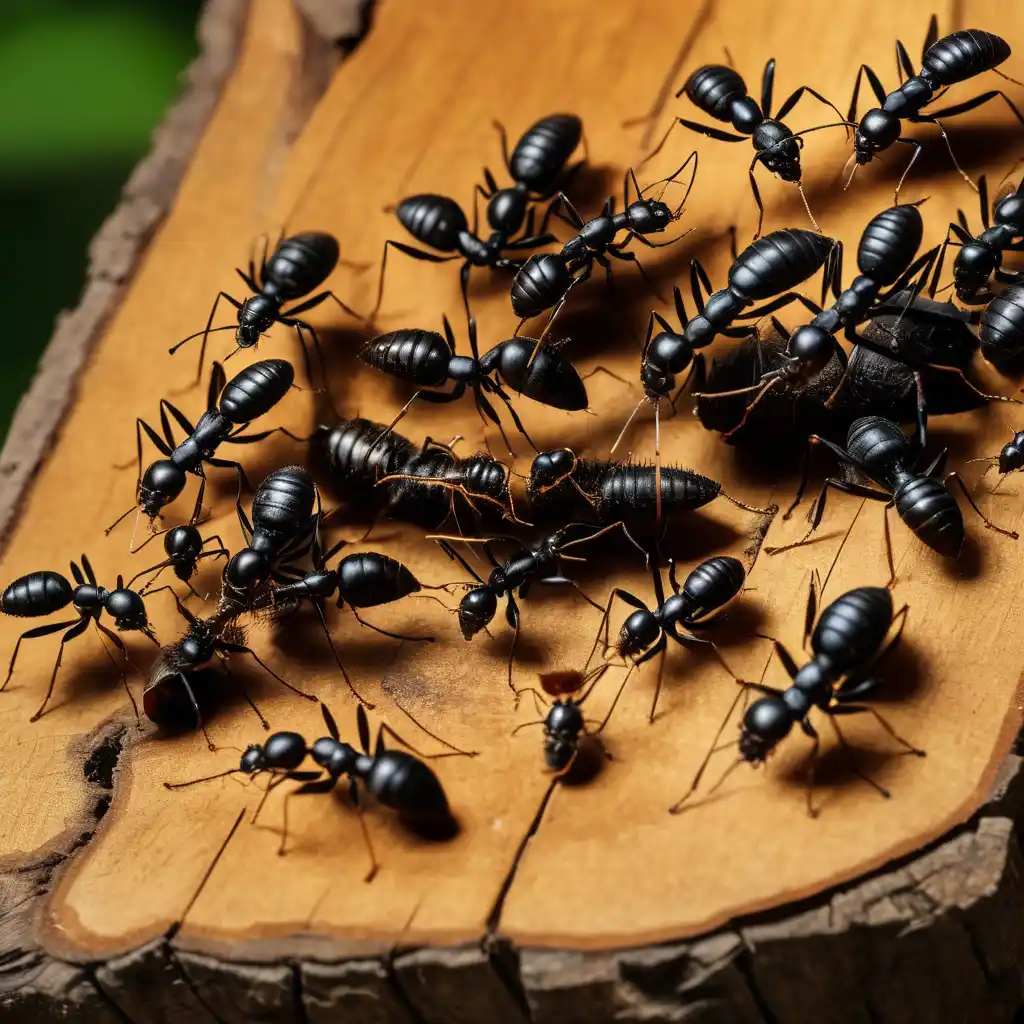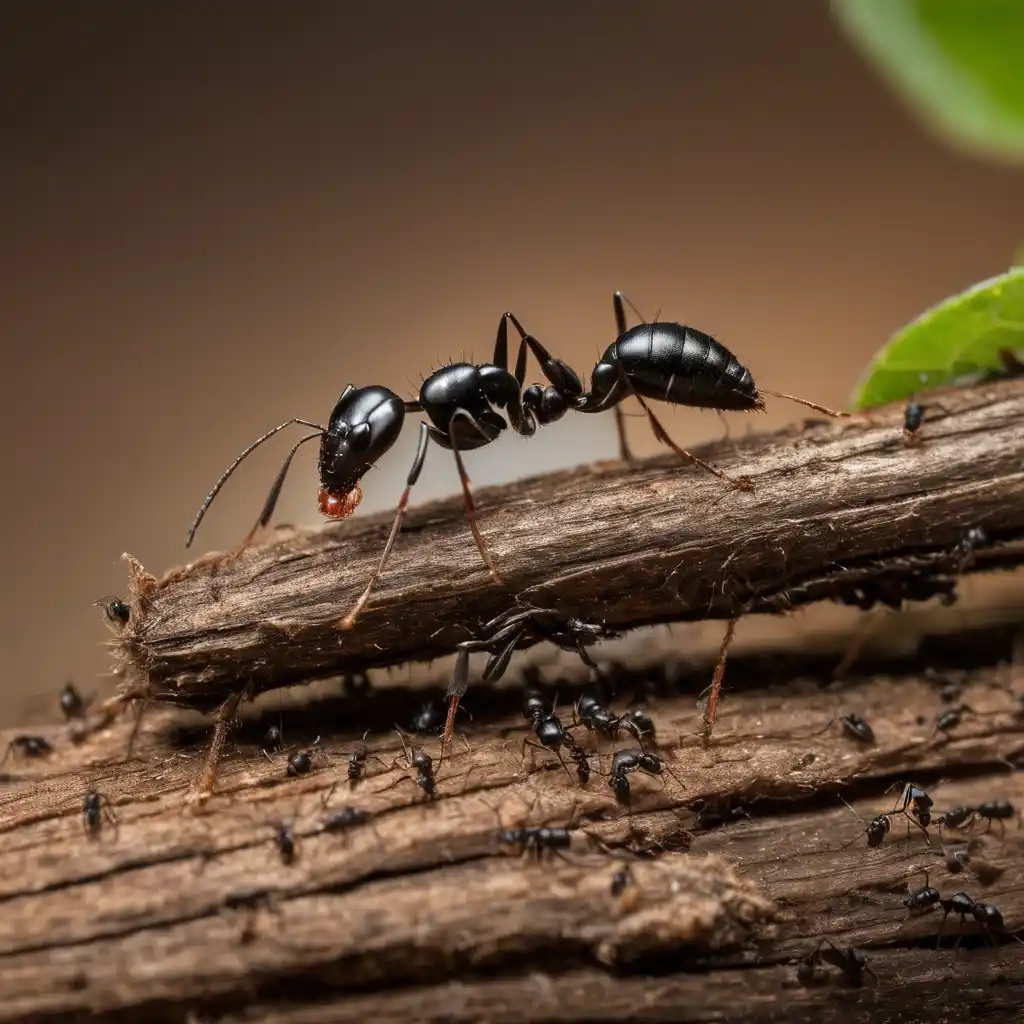Carpenter ants and black ants are two common types of ants you might encounter in your home or yard. However, despite their similarities, these two species differ in several key ways, from their size to the type of damage they can cause. If you’re wondering about the distinctions between carpenter ants and black ants, you’re in the right place. In this guide, we’ll explore their behavior, nesting habits, life cycles, and much more to help you understand the critical differences.
Carpenter Ants vs Black Ants: Identifying the Key Differences
When you spot ants in your home, it’s important to know what kind of ants you’re dealing with. Proper identification can help you prevent damage and protect your home from infestations. Let’s begin by examining the characteristics of carpenter ants and black ants.
What Are Carpenter Ants?

Carpenter ants are large, industrious ants known for their destructive nesting habits. They don’t actually eat wood like termites, but they do excavate it to create their nests, causing significant damage in the process.
Size, Color, and Behavior
- Size: Carpenter ants are among the largest ants you’ll find, typically ranging between ¼ to ½ inch in length. They are often black but can also be reddish or a combination of both colors.
- Behavior: Carpenter ants are active foragers, particularly during the warmer months. Unlike some ants, they don’t feed on wood but rather on insects, honeydew, and sugary substances.
- Personal anecdote: My cousin once noticed a trail of large ants leading from her kitchen to the backyard. It turned out they were carpenter ants searching for food. The size of these ants made them easy to distinguish from other types.
What Does a Carpenter Ant Nest Look Like?
- Carpenter ant nests are intricate networks of tunnels and galleries built into wood. You might notice piles of sawdust near wooden structures as a sign of their presence.
- Wood damage: Carpenter ant prefer moist or decaying wood, making areas like window frames, decks, and crawl spaces prime locations for their nests.
- Practical advice: If you find sawdust or wood shavings, it’s a red flag that carpenter ants might be tunneling through your wood. Check damp areas first because carpenter ants thrive in moisture.
What Are Black Ants?

Black ants, often referred to as common ants, are much smaller than carpenter ants and are typically less harmful. However, that doesn’t mean they can’t be a nuisance, especially when they invade your kitchen in search of food.
Recognizing Black Ants and Their Characteristics
- Size: Black ants are significantly smaller than carpenter ants, typically ranging between ⅛ to ¼ inch in length. They are black and smooth in appearance.
- Behavior: Black ants are opportunistic foragers, frequently entering homes in search of food, particularly sweet substances like syrup or fruit. They tend to build nests outdoors but can be found indoors near food sources.
- Real-life example: I once had an army of black ants invade my pantry after I left some honey on the counter. Even though they weren’t causing damage, their persistence in getting to the honey was enough to make me take quick action.
Winged Black Ants and Their Role in the Colony
- Winged ants: Black ants with wings are usually reproductive ants, also known as alates. These ants leave the colony to mate and start new colonies, which is why they are often spotted in large numbers during swarming season.
- Nesting: Black ants typically nest outdoors in soil, but they can also find their way into your home, particularly around foundations, under paving stones, or in wall voids.
Comparing Carpenter Ants and Black Ants: Size, Nesting, and Behavior
To differentiate between carpenter ants and black ants, it’s helpful to compare their size, nesting habits, and behavior.
Size Comparison:
- Carpenter ants are significantly larger than black ants, making them easier to identify. Their workers can be 3 to 5 times the size of a typical black ant. Additionally, carpenter ant soldiers are even larger than the workers.
- Black ants, on the other hand, are much smaller and more likely to be seen in larger groups, often foraging in lines toward food sources.
Nesting Differences: Tunnels, Wood, and Moisture
- Carpenter ants build their nests inside wood, preferring moist environments. Their nests consist of elaborate tunnels and galleries, which they carve out of wood structures. This can result in significant damage to homes, particularly in wooden beams and supports.
- Black ants generally nest outside, but they may move indoors if they find a reliable food source. They build their nests in soil, under rocks, or even under floorboards, but they don’t tunnel through wood like carpenter ants.
Behavior and Diet:
- Primarily feed on insects and sugary substances like honeydew. They often forage at night, which can make detecting an infestation tricky until the damage is noticeable.
- Black ants tend to seek out sweet foods as well but are more likely to invade kitchens and pantries, drawn to sugary spills or crumbs. Their foraging behavior is more aggressive and often occurs during the day.
Damage Caused by Carpenter Ants vs Black Ants
One of the most important differences between carpenter ants and black ants is the type of damage they can cause to your home.

Carpenter Ants Damage: Wood Destruction and Structural Risks
- It can cause significant structural damage because they hollow out wood to build their nests. Although they don’t eat wood, the large tunnels they create can weaken the integrity of wooden structures over time.
- Wood galleries: These ants prefer damp wood, so their presence can also signal a moisture issue in your home, such as leaky roofs or pipes.
Black Ant Damage: Are They Harmful?
- Black ants are generally harmless to structures. Their primary goal is to find food, and they don’t tunnel through wood. However, they can still be a nuisance, particularly if they get into your food storage.
- Practical advice: While black ants aren’t a serious threat, they can contaminate food and leave pheromone trails, which attract more ants.
Control and Prevention Methods
Now that we’ve covered the differences between carpenter and black ants, let’s explore the best ways to control and prevent infestations.
Controlling Carpenter Ants Infestations
- Locating nests: The first step to controlling a carpenter ant infestation is finding the nest. Look for signs of sawdust or small holes in wood, particularly in damp areas of your home.
- Bait and insecticides: Carpenter ant bait can be effective in drawing out workers, which then carry the poison back to the nest. Insecticide sprays can be applied directly to nests and tunnels for faster control.
- Prevention tips: Reduce moisture in your home by fixing leaks, improving ventilation, and ensuring proper drainage around your foundation.
Preventing and Managing Black Ant Infestations
- Sealing entry points: The best way to prevent black ants is to seal any cracks or crevices around doors, windows, and foundations. This limits their access to your home.
- Bait traps: Black ant bait traps can be placed near ant trails to attract workers. Once they bring the poison back to the colony, it can eliminate the nest.
- Keeping food sealed: Store food in airtight containers and clean up spills immediately to reduce the likelihood of attracting black ants.
Life Cycle and Colony Structure of Carpenter Ants vs Black Ants
Both have fascinating colony structures and life cycles that contribute to their survival and growth.
The Life Cycle of Carpenter Ants
- Queen and reproductive ants: The carpenter ant colony begins with a queen, who lays eggs and starts the colony. Over time, she produces workers, soldiers, and reproductive ants.
- Workers and larvae: The workers care for the larvae and expand the nest by excavating wood. Soldiers defend the colony against predators.
- Life cycle stages: Eggs hatch into larvae, which then develop into pupae before becoming adults. The whole process may take several months, depending on the surrounding environmental conditions.
The Life Cycle of Black Ants
- Queen and reproductive ants: Like carpenter ants, black ants have a queen who starts the colony and lays eggs. Winged ants are produced as reproductive ants, and they leave the colony to mate and form new colonies.
- Workers and larvae: Black ant workers care for the larvae, forage for food, and maintain the nest. The life cycle stages are similar to carpenter ants, but the process is generally shorter.
Diet and Feeding Habits
The diets of carpenter ants and black ants are similar in some ways but differ in their feeding behaviors and preferences.
What Do Carpenter Ants Eat?
- Primarily feed on other insects, honeydew, and sugary substances. They also scavenge for food sources around homes, particularly when outdoor food sources are scarce.
- Foraging behavior: it tend to forage at night, which can make it harder to detect their activity until you notice structural damage.
What Do Black Ants Eat?
- Black ants are attracted to sweet foods like sugar, honey, and fruit. They often invade kitchens and pantries in search of food, leaving a trail of ants behind them.
- Food storage tips: Keep food sealed and clean up crumbs to avoid attracting black ants. Their persistence can be overwhelming once they find a food source.
A Final Word About carpenter ants and Black ants
Understanding the differences between carpenter ants and black ants is crucial for protecting your home from infestations and damage. While carpenter ants pose a more significant threat due to their ability to damage wood, black ants can still be a persistent nuisance if they invade your home in search of food. By recognizing their unique behaviors, nesting habits, and dietary preferences, you can take appropriate action to control and prevent both types of ants.
FAQs
Q1: Can carpenter ants cause significant damage to a home?
A1: Yes, it can cause severe structural damage over time by tunneling through wood to build nests.
Q2: Are black ants harmful to humans or property?
A2: Black ants are generally not harmful but can be a nuisance when they invade homes in search of food.
Q3: How can I tell if the ants in my home are carpenter ants or black ants?
A3: Carpenter ants are usually larger and are often found near wood, whereas black ants are smaller and more likely to nest in soil or outside your home.
Q4: What should I do if I find carpenter ants in my home?
A4: Address moisture issues, locate and remove their nests, and consider using baits or professional pest control services to eliminate the infestation.
Q5: Do black ants with wings indicate a larger problem?
A5: Winged black ants are usually reproductive ants, and their presence can indicate a mature colony nearby.
Related Articles
September 26, 2024 by Alex Mitchell : The article outlines methods to eliminate flying ants, including natural remedies, DIY treatments, and prevention tips.

